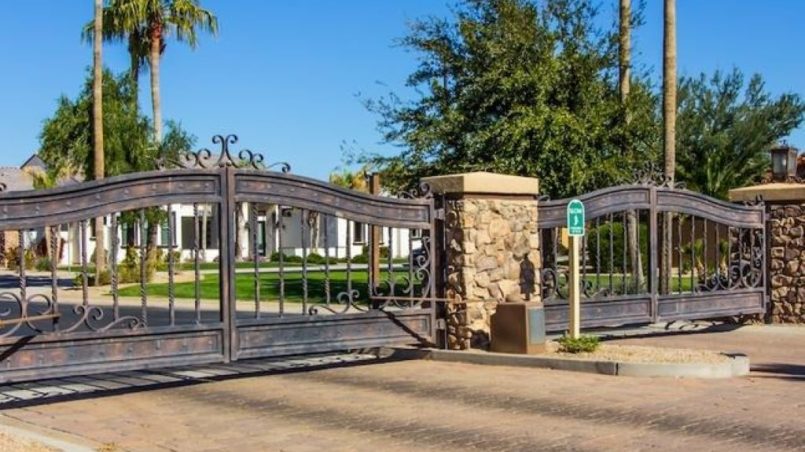Why Add Security Gates to a Home?
The decision to install security gates at a home is more than just a visual upgrade—it’s a practical response to growing concerns about neighborhood safety and property crime. Recent findings from the Pew Research Center reveal that, even as actual crime rates fluctuate, the perception of increased crime pushes homeowners to seek out more robust protective measures. Security gates stand out as one of those tangible, high-impact solutions that offer property owners a sense of immediate and lasting control over their space. Unlike other security options that can be costly to install and maintain, a quality gate is often a one-time investment that reaps rewards over many years, reducing the risk of unauthorized access and potentially lowering insurance premiums for the property.
Beyond just the psychological comfort, physical boundaries created by modern security gates Houston TX help prevent trespassers, solicitors, and errant vehicles from accessing driveways and entryways. Families can let children play or pets roam with fewer worries, confident that a sturdy barrier protects their household. Additionally, well-designed security gates often increase curb appeal, setting homes apart in the real estate market and potentially boosting resale value. When a gate matches the architecture of a house and functions flawlessly, it offers reassurance, convenience, and even a welcoming element for residents and guests.
Key Security Gate Features to Consider
Choosing a residential security gate means balancing security needs with lifestyle, budget, and personal taste. One of the most fundamental decisions is selecting materials; options like heavy-gauge steel, wrought iron, or aircraft-grade aluminum offer superior resistance against both weather and forced entry attempts. Investing in a gate made from durable material translates to lower maintenance costs over the long term, especially for those living in areas prone to rain, snow, or salt exposure.
- Durable Materials: Higher-end aluminum is lightweight yet strong, while steel and wrought iron offer classic aesthetics with top-tier protection. Materials can be combined for custom effects and extra resilience.
- Locking Systems: Flexibility is key—look for gates supporting both electronic (keypads, RFID) and manual overrides. These systems allow for easy guest access, convenient delivery routines, and peace of mind during power outages.
- Height & Design: Optimal security gates are at least six feet tall to deter climbing. Panels, spikes, or curved tops further discourage unwanted entry, while decorative touches keep the look appealing.
- Weather Resistance: Coatings such as powder finish or galvanization protect frames from oxidation, rust, and fading. This is particularly important in climates with rapid temperature swings or high humidity.
- Visibility: Some prefer see-through designs to monitor street activity, while others opt for opaque panels for maximum privacy. Consider street lighting and neighborhood activity to find the right balance.
Choosing these features based on real-world use—the number of daily entries and exits, local climate, or neighborhood norms—leads to gates that are both functional and long-lasting.
Popular Types of Residential Security Gates
Selecting a gate type is about much more than curb appeal—it shapes how you use your property day-to-day. Swing gates are the traditional choice, pivoting open much like a door. These gates look elegant and offer a variety of design possibilities, but they require a flat, spacious driveway to swing open fully. A slide gate may be a better solution for homes with limited entry space or sloped driveways. Slide gates glide open along a track, utilizing width instead of depth. These gates can be superb for urban lots or properties with landscaping or hardscape features close to the driveway.
When space is at a premium—imagine steep hillsides or awkward property lines—vertical pivot gates lift upward, making them an efficient and eye-catching solution. Each style brings its own blend of aesthetics, function, and maintenance needs. For those dedicated to blending beauty and safety, trends in creative garden gate ideas highlight materials, shapes, and colors that elevate front-yard security to an art form. Matching the choice of gate to your home’s personality ensures your investment is both secure and visually inviting.
Installation Factors and Professional Insights
Professional guidance is invaluable for anyone considering a residential security gate. Experts thoroughly assess property lines, soil stability, and topography, all of which influence gate longevity and function. For example, loose or sandy soil may require deeper footings or reinforced posts to prevent sagging. Installers also examine driveway length and slope to determine optimal gate placement and swing arc or track layout.
Local codes and homeowners’ association regulations should be checked before construction begins to avoid costly mistakes or future conflicts. To maximize safety and traffic flow, many municipalities set minimum distances for gates from roads, sidewalks, and entryways. The choice between manual or powered operation (including solar-powered options) often depends on available power sources and preference for convenience. Automation may require trenching for electrical lines or mounting solar panels for motorized gates. Bringing in industry professionals from the outset helps prevent delays, unexpected fees, and installation errors, and it often leads to a finished product that stands the test of time.
Technology and Automation for Modern Gates
Security gate technology has evolved from simple latches to full smart-home integration. Today, homeowners expect remote entry through smartphone apps, automated schedules, and seamless connectivity to home security systems. Smart gate technology now lets individuals assign temporary codes to guests, receive notifications about gate activity, or view real-time video from built-in cameras. If a delivery arrives and you’re not home, the gate can be opened with a tap on your phone, then locked again in seconds.
According to Security Magazine, future-forward gates are expected to offer even more customization—such as geofencing and voice assistant integrations—streamlining access control further. Solar-powered gate motors are also rising, reducing environmental impact and eliminating the hassle of running underground electrical wires. For tech-savvy homeowners, choosing automation-ready models future-proofs your investment and often enhances resale value.
- Remote entry and scheduling: Open, lock, or customize schedules from anywhere via app or smart home dashboard.
- Live surveillance integration: Pair your gate with cameras and intercoms for an added layer of protection.
- Temporary access codes: Provide secure entry for guests, service workers, or deliveries—automatically expire after use.
- Eco-friendly power: Solar automation is cost-effective, reliable, and sustainable for many properties.
Tech brings convenience and control right to your fingertips, providing real-time status, alerts, and peace of mind whether you’re home or away.
Keeping Security Gates in Top Condition
- Monthly Inspections: Regularly check hinges, rollers, tracks, and cables for signs of wear, debris, or rust. Catching minor issues early often prevents major repairs later on.
- Lubrication: Use silicone spray or all-weather grease on moving parts, especially before winter or rainy seasons when moisture is high.
- Fastener Checks: Tighten bolts, nuts, and brackets at least twice a year. Gate movement can gradually loosen hardware over months of use.
- Testing Safety Features: Automated gates should be checked monthly for functioning sensors, obstacle detection, and backup battery reliability.
- Annual Professional Tune-up: Schedule an expert for a thorough check, especially if your system is automated or sees heavy daily use.
Preventative care ensures your gate remains a secure, smooth-operating asset instead of a liability. Well-maintained gates last longer and continue to protect your family for years to come.
Safety Best Practices for Families
Gaining security should not mean sacrificing everyday safety. It’s essential to teach all household members—including kids—about the dangers of standing near a moving gate or attempting to climb it. Pets should be kept away from gates to avoid accidental trapping or injury. All automated systems must feature reliable obstacle sensors that stop operation if a person, pet, or object is detected. Emergency release levers should be clearly marked and easily accessible so that everyone knows what to do if the power fails or automatic controls malfunction.
Posting instructions and contact numbers in a visible location near the gate (or inside the home) is a wise precaution, particularly for houses that host frequent visitors. For multi-generational homes, making information available in large print or multiple languages can avoid confusion in stressful situations. Safety habits, much like sturdy gates, offer protection you can count on.
Trends Shaping Security Gates
Security gates rapidly shift from purely functional devices to smart, sustainable, and stylish home additions. Across neighborhoods, solar-powered motors reduce utility bills and carbon footprints, while composite and recycled materials are gaining popularity for their low maintenance and eco-friendly appeal. Touchless and biometric entry systems—once the domain of high-end commercial sites—are becoming approachable and accessible for everyday homes.
Style, too, matters more than ever. Many modern homeowners seek to match their gates to home exteriors, choosing from minimalist horizontal slats, ornate wrought iron, or even custom laser-cut designs, adding artistic flair to their property’s boundary. As the integration of smart technology continues and eco-consciousness rises, security gates will continue to evolve, blending robust protection with personalized innovation.



